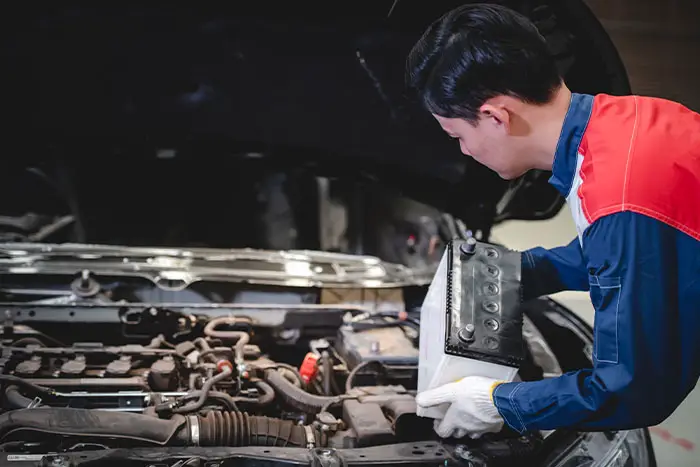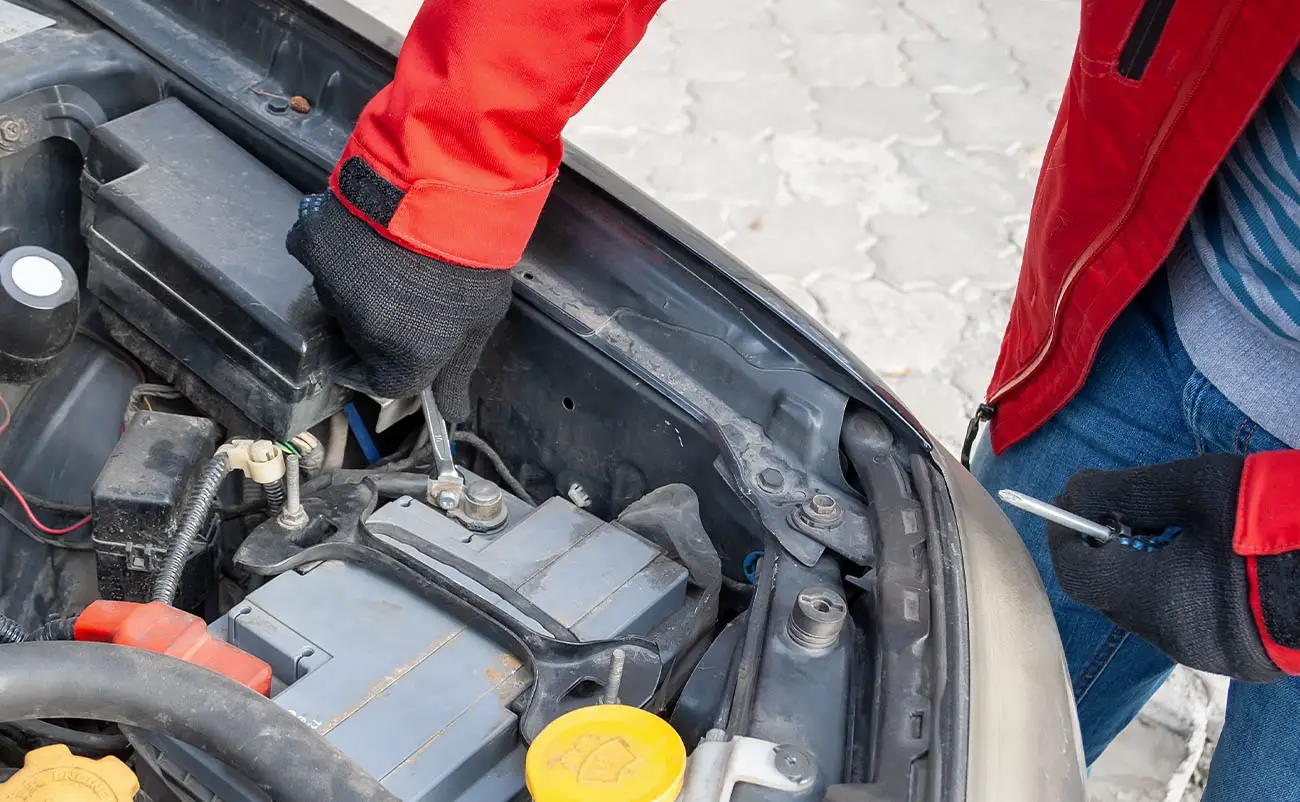Disconnecting a car battery might sound like a simple task, but there is a right and wrong way to do it. You might need to disconnect your car’s battery for a variety of reasons, like resetting the check engine light or replacing the battery. Whatever the reason, using the wrong steps to disconnect the battery could lead to damage to your car’s electrical system. In the worst case, it could also result in an electrical shock. If you need to disconnect your battery, keep reading and follow the steps outlined below.
Table of Contents
How To Disconnect A Car Battery The Right Way
When it’s time to disconnect a battery, some people might just grab a wrench and start disconnecting battery cables. However, there is a proper way to perform this task! Doing it the right way will ensure that your car’s electrical system is not harmed, and it can also keep you from getting shocked. Here is how to disconnect your battery the proper way.
— Step 1: Locate The Battery
This step might seem obvious, but it’s not always as easy as it sounds on some new cars. The battery on most cars is located under the hood, although some batteries are located on the driver’s side while others are on the passenger side. The battery might be somewhat hidden by a plastic cover, so make sure you look thoroughly. Some vehicles even have the battery located in the trunk, and some new cars also have auxiliary batteries located in the trunk or under a seat. Once you locate the car’s main battery, it is time to move on to the next step.
— Step 2: Identify The Battery Terminals
Your battery will have two terminals located either on the side or top of the battery – the positive terminal and the negative terminal. Identifying these terminals is critical to performing the next steps, as they need to be removed in a specific order. There are a couple of ways you can tell the difference between positive and negative battery terminals. First, there should be a ‘+’ and ‘-’ stamped on the battery beside the terminals. The terminal with the plus sign is the positive terminal, and the terminal with the minus sign is the negative terminal. You should also notice that the battery cable connected to the positive terminal is red, while the cable connected to the negative side is black.
— Step 3: Disconnect The Negative Terminal
So, do you disconnect the positive or negative first? You will always want to disconnect the negative battery cable first. Removing the negative terminal first is important because removing the positive cable first could result in an electrical short and damage your vehicle. Remember that the negative cable is the one that attaches to the terminal with the minus sign, and the cable and connector should be black. Find a wrench or socket wrench that fits the nut on the battery terminal connector and loosen the nut. Once the connector is loosened, you can remove it from the battery terminal. Make sure to fully remove it from the terminal and push it far to the side to avoid contact with the terminal.
— Step 4: Disconnect The Positive Terminal
Now it is time to disconnect the positive terminal. This will be the cable with the red connector that connects to the terminal beside the plus sign on the battery. You should be able to use the same wrench for the positive connector that you used on the negative connector. Loosen the nut on the connector and remove the connector from the terminal. Again, you will want to push the connector as far away from the terminal as possible. Be aware that some newer vehicles may have fuse panels or small electrical boards connected directly to the positive terminal of the battery. Be extremely careful when disconnecting and moving the positive cable to avoid damaging these parts.
— Step 5: Remove The Battery, If Necessary
In some cases, it will be necessary to remove the old battery from the car at this point. If you are wondering how to remove a car battery, here is how to do it. The battery sits in the battery tray and is held in place using a battery hold-down clamp. You will need to remove the clamp by using a socket wrench and ratchet. Usually, a socket extension will also be required. The socket size needed will vary by vehicle. Once the clamp is removed, the battery should be loose in the tray and can be lifted out of the vehicle. Some batteries fit tightly into the tray, and you might need to tilt or twist the battery to remove it from the vehicle.
When Do You Need To Disconnect A Car Battery?

Disconnecting a car battery is not something that you need to do often, but there are some situations when it is necessary. So, just when would you need to disconnect your battery? Here are a few instances where disconnecting your battery is required. Remember to always use proper safety equipment, like gloves and safety goggles, before attempting to disconnect your battery.
— Performing Certain Types Of Maintenance
Certain types of maintenance or repairs require that you disconnect the battery before performing the work. This is usually required to avoid damage to the vehicle and to avoid electrical shock to the person performing the work. Typically, the battery should be disconnected before performing any work involving an electrical component. This could include a sensor, the radio, an electric fuel pump, the alternator, or anything else that requires an electrical connection. Once the repair is completed, you can reconnect the battery.
— Replacing The Battery
Batteries don’t last forever, so your car will need a new battery eventually. Typically, batteries last anywhere from three to five years. When your old battery goes bad, you will need to disconnect and remove it to replace it with a new battery. Replacing your battery is one of the most common reasons to disconnect your battery, and you might not even have to do the work yourself in this case. Many auto parts stores will replace your battery for free if you purchase the new battery from them.
— Charging The Battery
If your battery gets drained for some reason, like leaving the lights on or a bad alternator, you will need to recharge it. Although you don’t necessarily need to remove the battery to recharge it, you should always disconnect it first. You don’t want the current from the battery charger entering your car’s electrical system, as this could damage sensitive electrical components. Simply disconnect the battery and then connect the battery charger. The amount of time needed to charge the battery will depend on the size of the battery, the strength of the charger, and how low the dead battery was to start with.
If you simply need to jump-start your vehicle with a set of jumper cables, you will need to leave the battery connected. Otherwise, the current will not flow to your car’s starter, and your vehicle will not crank.
— Storing Your Vehicle
If you have a vehicle that you don’t drive frequently, you should disconnect the battery when it is not in use. Leaving the battery connected will slowly drain the battery, and this can cause the battery to go bad fairly quickly. Disconnecting the battery will help it last much longer, and it can prevent electrical issues in the vehicle too. If you plan to store your vehicle for more than two weeks without driving it, you should disconnect the battery.
— Resetting Trouble Codes
Check engine lights can be pesky, and many people look for an easy way to reset them. The proper way to reset a check engine light is by using an automotive scan tool, but not everyone has access to one of those. You can also reset trouble codes or warning lights by disconnecting the battery. Just disconnect the battery and leave it disconnected for 15 to 30 seconds. This will allow enough time for the computer to lose power, and the codes will be cleared. Reconnect the battery and start your vehicle. If the trouble code returns, you likely have a problem that needs to be repaired.
Special Considerations When Replacing A Car Battery
When you replace your car battery, there are sometimes a few other things you need to do besides just removing the old battery. You will typically want to clean your battery terminals to ensure they are free of rust and corrosion. Corrosion prevents a good connection to the terminal, and it could cause problems with your vehicle. Use some baking soda and a wire brush to thoroughly clean the connectors. You can also place a small amount of anti-corrosion grease on the battery posts when reconnecting the new battery. This will help prevent corrosion from forming.
You should also be aware that almost all new batteries have plastic caps over the terminals. These caps help prevent unintentional grounding or discharging of the battery. However, they must be removed before connecting the battery cables. A car battery terminal should be bare metal, so make sure that all the plastic on the terminal has been removed before you try to connect the battery cables. When reconnecting your new battery, you should always connect the positive terminal first and then the negative terminal. If you need to know how to connect a car battery, simply reverse the process you used for disconnecting the old battery.
The Bottom Line
Disconnecting a car battery is not that difficult, but you should ensure that you perform the proper steps to do it correctly. Otherwise, you could damage electrical components in your vehicle. Simply locate the battery, identify the terminals, disconnect the negative terminal, disconnect the positive terminal, and then remove the battery.
Frequently Asked Questions
Why do you disconnect the negative battery terminal first?
You disconnect the negative terminal first to avoid unintended shorting of the system. If the positive terminal is disconnected first, a slip of your wrench could short-circuit the system. This could cause electrical shock, and it could arc and start a fire. In addition, electrical components in your car could be damaged in the process.
What are some risks of disconnecting the battery?
There are really no major risks to disconnecting the battery as long as the process is done properly. It is possible that you may need to reset the clock in your vehicle after disconnecting the battery, and your radio presets could be lost. If not done properly, you could shock yourself or damage your car’s electrical system. So, you should always follow the proper steps to disconnect the battery.
What is the difference between a dead car battery and a discharged car battery?
These two terms usually refer to the same thing. A dead or discharged battery usually operates at less than 12 volts. This is not enough voltage to run the electrical system or turn the starter on the vehicle. If you have a dead battery, you will need to recharge it. If the battery is not fully discharged, you should be able to jump-start your vehicle and let the alternator charge it while you drive. If the battery is fully discharged, you will need to connect it to a battery charger.

